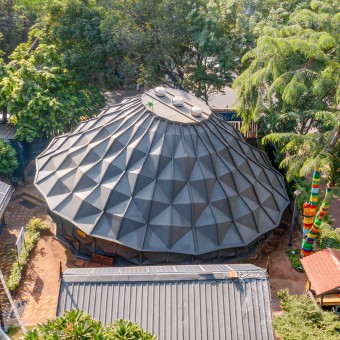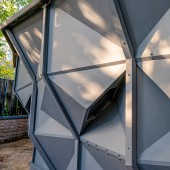|
|
|


|
|
| DESIGN DETAILS |
DESIGN NAME:
Darwin Bucky
PRIMARY FUNCTION:
Exhibition Gallery
INSPIRATION:
Bucky is inspired by Buckminster Fuller's geodesic dome. The project is envisioned to be a traveling gallery complemented by its aesthetic architecture for curators to exhibit their work anywhere in the world. One of the major inspirations was to create a gallery that it should be designed for repurposing and can be recycled or deconstructed to minimize unnecessary footprints.
UNIQUE PROPERTIES / PROJECT DESCRIPTION:
Bucky is designed as a complete set of parts that can be assembled and disassembled if necessary at the site. It is a parametric dome tent anchored to the ground without a foundation. Bucky can be used as an exhibition gallery or a center for performance or a bar or a nightclub. The structure is a black box that provides a wide array of programs that could be decided by the tenant who rents by the day. It is designed to be placed in public gardens or exhibition grounds or even in a city square always permanently temporary provide the ground is flat.
OPERATION / FLOW / INTERACTION:
Gallery is always perceived as a four walled box. Bucky transforms the way people experience galleries by making the building itself a part of the exhibition. People will interact the same way with the building as they interact with the exhibits inside it.
PROJECT DURATION AND LOCATION:
Located in Ahmedabad, Gujarat, India. The project started in October 2019 and was made open to public in October 2021.
|
PRODUCTION / REALIZATION TECHNOLOGY:
The structure is made using 1mm mild steel spanning a massive 10 meters and 6 meters in height without beams or columns. The Avant grade joinery system makes the structure leakproof and conceals more than 70 percent of the 2800 bolts which is an impossible task to achieve for a component that has naked edges on all four sides as the panels need to be collapsible. The panel size can be easily handled by one person making the assembly extremely efficient.
SPECIFICATIONS / TECHNICAL PROPERTIES:
Diameter - 10m
Height - 6m
Material - Mild Steel
Panels - 324
Panels size - min 300mm and max 1250mm
Other components - 200
Joinery size - min 35mm - 1500mm
Number of Bolts - 2800
Technology - Machine folding and parametric modeling
Weather - all seasons
TAGS:
Parametric design, Origami, travelling gallery, temporary structure, Buckminster fuller, geodesic dome, modular structure, metal folding, flat pack structure, light weight structure
RESEARCH ABSTRACT:
Bucky was designed with the aim of making a travelling gallery that can be transported anywhere in the world in a 6 meter shipping container. Origami was the basic methodology used to figure out the panel folding of the building and with the help of parametric tools the fabrication was done onsite. As a result Bucky was able to be fit in a container as well as convert itself into a huge 100 square meter gallery within a matter of days.
CHALLENGE:
The challenge was to construct a typology that works for off-grid areas. The criteria to fit a 10meter span and 6meter height structure into a 6meter container was a difficult task since Bucky was envisioned to be easy to carry around the globe. Adding further, making an open system into a closed system was also a major challenge which was necessary to make the building as watertight as that would ruin the artworks. The windows are designed to have indirect lighting without having rainwater through the opening to protect the painting from any harsh environmental conditions.
ADDED DATE:
2022-03-07 14:45:23
TEAM MEMBERS (3) :
Lead Parametric Designer: Kuber Patel, Lead Architect: Jwalant Mahadevwala and Client: Abbhay Mangaldas
IMAGE CREDITS:
Vinay Panjwani, Kuhoo Patel
|
| Visit the following page to learn more: http://www.kuberpatel.com/ |
|
| CLIENT/STUDIO/BRAND DETAILS |
 |
NAME:
Kuber Patel
PROFILE:
Kuber graduated [year March 2016] with Masters of Architecture in Emergent Technologies and Design from the Architectural Association School of Architecture, London, and has a total of 6+ years of global professional experience. In addition, he is also a visiting faculty at CEPT University and the author of the book 'Algorithmic Thinking- A parametric approach to problem-solving '. His most recent achievement includes being accepted to work in the U.S. as an Individual with Extraordinary Ability or Achievement. He strives to achieve his goals by developing high-quality skillsets and sheer passion rather than through experience because of which he has been the youngest local architect of the World's Largest Cricket Stadium, the youngest faculty to lead a master studio, and the youngest to start his first project in 2010 much before his undergrad in 2013.
His skills work best in parametric modeling through algorithmic design techniques using advanced computational tools and digital fabrication. Kuber hopes to add more value to design by introducing a more data-driven process through computer science, mathematical thinking, and philosophy. As we live in a post-digital world, this data, if given the right manifestation, can lead to a well-informed architecture representing a better reality and a responsive future. He would like to add to his studio a more concise approach to the translation process of architectural representation rather than the invention of a new architecture.
Kuber has been practicing Architecture since 2013 soon after his graduation working on projects in USA, UK & India. He always plays a lead and critical role in all the projects he gets involved. He has worked on stadiums, hotels, museums, temporary structures, pavilions, retail, residential, art installation, housing, mixed-use, commercial and corporate buildings. Kuber has been extensively published in an article titled use of glass in bridges by Surface Reporter due to his innovative use of glass on facades. He also gets frequently invited as a Jury panel by top-ranking universities. One of his beloved projects is Bucky, the first of its kind largest Prefabricated modular traveling gallery developed entirely using a parametric workflow. One of his innovative academic projects 'The Twist' pavilion received a small project award for its innovative use of plywood.
In the future, he wishes to pursue his Ph.D. in Architectured materials through selective laser sintering techniques. Overall, his architectural style mostly revolves around Performance orientated design that has a strong response to material, structural, social, and environmental behavior. Kuber's graduate thesis reflects on a similar system using agent-based methods to work on developing a flood resilient system that has a coherent spatial configuration between climate and the socio-economic fabric of informal settlements in an urban context.
|
|
|
| COMMENTS |
| Giulia Esposito |
Comment #15597 on December 28, 2022, 2:20 am |
|
I am absolutely in awe of the "Darwin Bucky" Exhibition Gallery created by Kuber Patel and Jwalant Mahadevwala. This work is a remarkable example of generative, algorithmic and parametric design, and it is no wonder that it has earned them such a prestigious award. The fact that it is an interactive space which allows the users to experience the beauty of nature through an immersive and innovative experience is truly remarkable. The attention to detail and the thoughtful design elements used to create this space are impressive and inspiring. I am sure Kuber Patel and Jwalant Mahadevwala can be proud of this accomplishment and I hope to witness many more of their creative and innovative works in the future.
|
| Adam Harris |
Comment #86704 on January 4, 2023, 12:57 pm |
|
This work is a stunning example of design excellence and innovation. The concept behind the “Darwin Bucky” exhibition gallery is truly impressive in its ability to be transported to any area of the world in a 6 meter shipping container and then open up to a 100 square meter gallery in a matter of days. The use of parametric tools to create a black box that can be used as a wide array of programs is ingenious in its flexibility and ability to provide a space for performance, a bar or a nightclub. Moreover, the dome tent anchored to the ground without a foundation is inspired by Buckminster Fuller’s geodesic dome and is a great example of utilizing origami for panel folding. This work is a remarkable display of creativity and research and is a wonderful testament to the power of design.
|
| Chloe Turner |
Comment #92616 on January 4, 2023, 7:23 pm |
|
I'm in awe of the creativity and ingenuity of this award-winning project! It's clear a lot of thought was put into the design of the gallery, inspired by Buckminster Fuller's geodesic dome, to make it travel-friendly, repurposeable, and sustainable. This gallery is a true testament to the artists' commitment to environmental consciousness and their passion for art and design. I'm so impressed by this innovative project and the way it brings together art and sustainability in a powerful way. Congratulations to Kuber Patel and Jwalant Mahadevwala for their incredible achievement!
|
| Mark Allen |
Comment #94556 on January 4, 2023, 10:20 pm |
|
This amazing work of art and design is truly inspiring! The combination of parametric design, generative algorithms and innovative fabrication techniques to create a structure that could be transported and assembled in any location is truly remarkable. It's a testament to the designer's creative vision and technical expertise that they were able to create a viable solution that is not only aesthetically pleasing, but also extremely functional. The exhibition gallery provides a unique and versatile space that can be used for any kind of event, from art exhibitions to performance centers. Congratulations to the designer of this impressive work!
|
| Elisabeth Clark |
Comment #95259 on January 4, 2023, 11:53 pm |
|
I am utterly impressed with Kuber Patel and Jwalant Mahadevwala's award-winning work, Darwin Bucky! The idea to create a travelling gallery using parametric tools and origami is truly inspiring, and their design is a great example of innovative and sustainable architecture. By combining technology and aesthetics, they have successfully created a space that can be used for a wide range of purposes and can be recycled or deconstructed to minimize unnecessary footprints. I am amazed by the sheer brilliance of their design and their commitment to creating a sustainable design that can be used anywhere in the world. Congratulations to Kuber Patel and Jwalant Mahadevwala for their success - this is a well-deserved award!
|
|
|
Did you like Kuber Patel and Jwalant Mahadevwala's Generative Design?
You will most likely enjoy other award winning generative design as well.
Click here to view more Award Winning Generative Design.
Did you like Darwin Bucky Exhibition Gallery? Help us create a global awareness for good generative design worldwide. Show your support for Kuber Patel and Jwalant Mahadevwala, the creator of great generative design by gifting them a nomination ticket so that we could promote more of their great generative design works.
|
|
|
|
|
|









